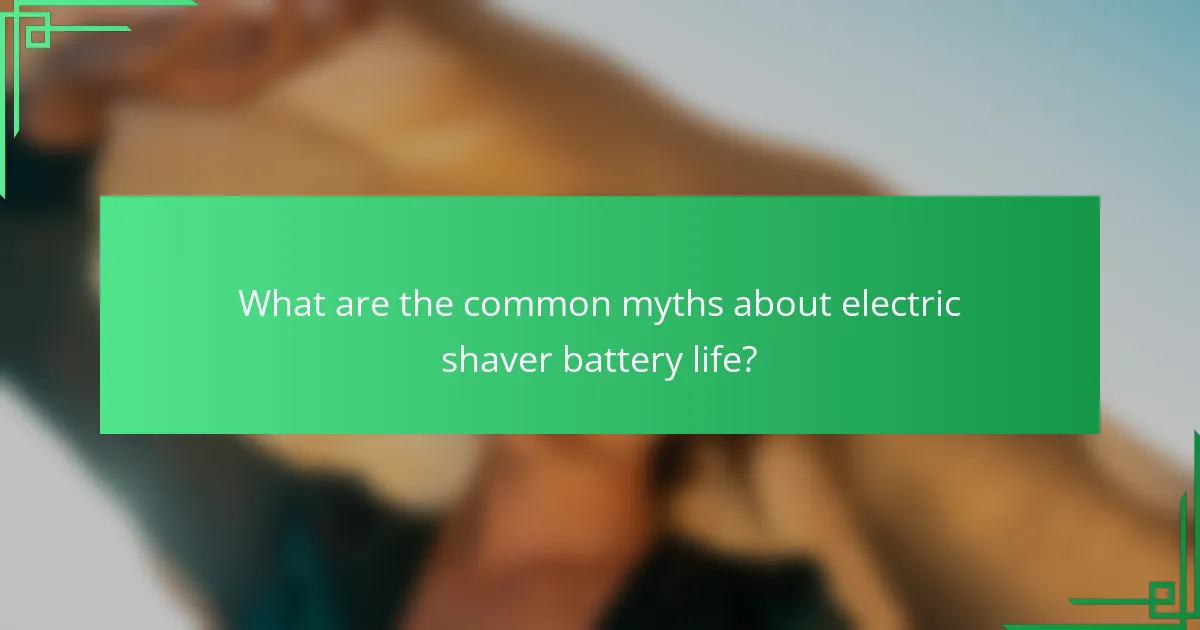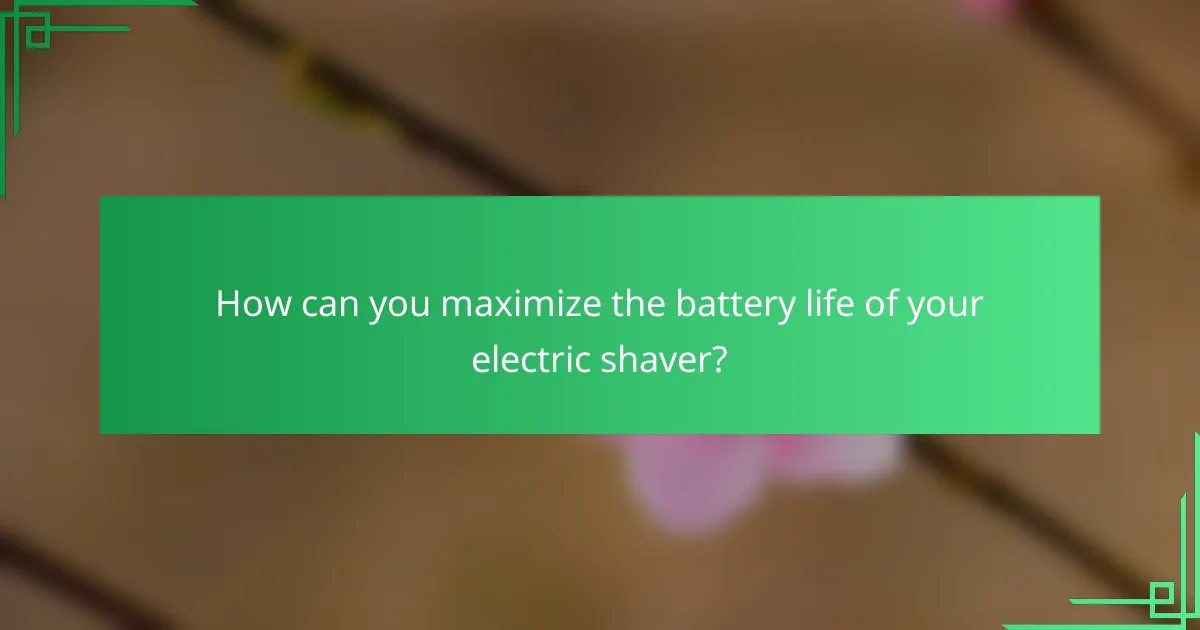Electric shaver battery life is often misunderstood, with several common myths influencing user practices. This article debunks misconceptions such as the need to fully drain lithium-ion batteries before recharging and the belief that constant charging improves battery longevity. It highlights the importance of proper maintenance, including regular cleaning and adherence to manufacturer charging guidelines, to enhance battery performance. Additionally, it clarifies that factors like usage habits and shaver design are more critical than brand reputation in determining battery life. By following recommended care practices, users can extend the lifespan of their electric shaver batteries effectively.

What are the common myths about electric shaver battery life?
Common myths about electric shaver battery life include the belief that all batteries need to be fully drained before recharging. This is not true for modern lithium-ion batteries, which do not suffer from memory effect. Another myth is that leaving the shaver plugged in all the time will extend battery life. In reality, this can lead to overheating and reduce battery longevity. Some people think that a higher voltage means better performance. However, the quality of the battery and the shaver’s design are more critical factors. Additionally, many believe that battery life is solely determined by the brand. In fact, usage habits and maintenance play significant roles in battery longevity.
How do these myths impact consumer choices?
Myths about electric shaver battery life significantly influence consumer choices. Consumers often believe that higher mAh ratings guarantee longer usage times. This misconception can lead to purchasing decisions based on misleading specifications. Many consumers overlook other critical factors, such as charging technology and motor efficiency. Misunderstanding battery life can result in dissatisfaction with product performance. Additionally, myths may cause consumers to favor brands that perpetuate these beliefs. This can skew market trends and affect brand loyalty. Ultimately, these myths can lead to wasted money on products that do not meet expectations.
What are the most prevalent misconceptions regarding battery longevity?
One prevalent misconception regarding battery longevity is that fully discharging a battery before recharging it extends its life. In reality, lithium-ion batteries, commonly used in electric shavers, perform better when kept between 20% and 80% charge. Another misconception is that leaving a battery plugged in constantly will not harm it. However, prolonged exposure to high voltage can lead to overheating and degradation. Additionally, many believe that cold temperatures will enhance battery performance. In fact, extreme cold can reduce a battery’s efficiency and lifespan. These misconceptions can lead to improper battery care and reduced longevity in devices.
Why do people believe these myths?
People believe these myths due to a lack of accurate information. Misunderstandings about battery technology often lead to incorrect assumptions. Personal anecdotes and anecdotal evidence can reinforce these beliefs. Marketing tactics may also promote misleading claims about battery life. Additionally, cognitive biases can cause individuals to favor familiar narratives over factual data. Confirmation bias leads people to seek out information that supports their pre-existing beliefs. This creates a cycle where myths are perpetuated rather than corrected. Overall, misinformation and psychological factors contribute to the persistence of these myths.
What is the actual lifespan of an electric shaver battery?
The actual lifespan of an electric shaver battery typically ranges from 2 to 5 years. Most lithium-ion batteries, commonly used in electric shavers, maintain optimal performance for about 500 to 800 charge cycles. After this period, battery capacity may decline significantly. Factors such as usage frequency and charging habits also affect lifespan. Regular maintenance can extend battery longevity. Users should follow manufacturer guidelines for optimal care.
What factors influence the battery life of electric shavers?
Battery life of electric shavers is influenced by several factors. These factors include battery capacity, which is measured in milliampere-hours (mAh). Higher capacity batteries typically provide longer usage times. The age of the battery also affects performance. Older batteries tend to lose their ability to hold a charge effectively.
Charging habits play a significant role as well. Frequent overcharging can degrade battery life over time. Additionally, the type of motor used in the shaver can impact power consumption. Efficient motors help extend battery life. The frequency of use also matters; more frequent use drains the battery faster. Lastly, environmental conditions, such as temperature, can affect battery performance. Extreme temperatures can lead to reduced efficiency and shorter battery life.
How do different brands compare in terms of battery performance?
Different brands of electric shavers exhibit varying battery performance. For instance, Braun shavers often feature lithium-ion batteries that provide up to 60 minutes of runtime on a full charge. Philips models, on the other hand, may offer similar or slightly lower performance, ranging from 40 to 60 minutes depending on the model. Panasonic shavers frequently emphasize quick charging capabilities, achieving a full charge in about an hour for comparable usage times.
In contrast, some budget brands may only deliver 30 to 40 minutes of shaving time. The battery life is influenced by the motor’s efficiency and the shaver’s design. Higher-end brands typically invest in advanced battery technology, enhancing longevity and performance. Therefore, when comparing battery performance, premium brands generally outperform budget options in terms of both runtime and charging speed.

How can you maximize the battery life of your electric shaver?
To maximize the battery life of your electric shaver, charge it fully before first use. Regularly charging the shaver after each use can help maintain battery health. Avoid overcharging, as it can shorten battery lifespan. Keep the shaver clean and well-maintained to ensure efficient operation. Use the shaver on the recommended hair types for optimal performance. Store the shaver in a cool, dry place to prevent battery damage. Following these practices can extend battery longevity significantly.
What maintenance practices help extend battery life?
Regular maintenance practices can significantly extend battery life. Keeping the battery clean prevents corrosion and buildup. Regularly charging the battery, rather than letting it completely discharge, helps maintain its capacity. Avoiding extreme temperatures can also protect battery health. Storing the battery in a cool, dry place is essential. Using the appropriate charger ensures optimal charging conditions. Following these practices can lead to a longer-lasting battery. Studies indicate that proper care can increase battery lifespan by up to 50%.
How often should you charge your electric shaver for optimal performance?
Charge your electric shaver after every use for optimal performance. Regular charging ensures the battery remains healthy and maintains its capacity. Most electric shavers have lithium-ion batteries, which perform best when kept charged. Allowing the battery to fully deplete before charging can shorten its lifespan. Manufacturers recommend not letting the battery drop below 20%. Following these guidelines helps maintain shaving efficiency and longevity of the device.
What charging habits should you avoid?
Avoid overcharging your electric shaver. Overcharging can lead to battery degradation. It is important to unplug the device once fully charged. Continuous charging can cause overheating. Avoid using the shaver while it is charging. This can also affect battery performance. Do not charge the shaver in extreme temperatures. High heat can damage the battery. Lastly, avoid letting the battery drain completely before recharging. This practice can shorten the overall battery lifespan.
What are the signs of a failing battery in an electric shaver?
Signs of a failing battery in an electric shaver include reduced runtime and inconsistent power. A shaver may struggle to maintain a charge, requiring frequent recharging. Users might notice that the shaver operates slower than usual. Additionally, the battery may swell or show physical damage. If the shaver fails to turn on despite being charged, this indicates a battery issue. These signs correlate with common battery degradation patterns observed in rechargeable devices.
How can you troubleshoot battery issues effectively?
To troubleshoot battery issues effectively, start by checking the battery connections. Ensure they are clean and secure. Next, inspect the battery for any signs of damage or swelling. If the battery appears damaged, it may need replacement. Test the battery voltage using a multimeter to confirm if it holds a charge. If the voltage is low, consider charging the battery fully. Additionally, verify if the charger is functioning properly by testing it with another battery. If problems persist, consult the manufacturer’s guidelines for specific troubleshooting steps.
When should you consider replacing the battery?
Consider replacing the battery when it no longer holds a charge effectively. If the battery drains quickly or requires frequent recharging, it may be time for a replacement. Additionally, if the battery shows signs of physical damage or swelling, replacement is necessary. Most rechargeable batteries have a lifespan of 2 to 3 years. After this period, performance typically declines. Monitoring these factors can help maintain optimal functionality of your electric shaver.

What are the best practices for electric shaver battery care?
To care for an electric shaver battery, regularly charge it according to the manufacturer’s instructions. Avoid letting the battery completely discharge before recharging. This practice helps maintain battery health and longevity. Store the shaver in a cool, dry place to prevent overheating. Clean the shaver after each use to avoid debris buildup that can affect battery performance. Use the shaver frequently to keep the battery active, as infrequent use can lead to battery degradation. Replace the battery when it no longer holds a charge effectively, as this is a normal part of battery life. Following these practices can extend the overall lifespan of your electric shaver battery.
How does temperature affect electric shaver battery life?
Temperature significantly affects electric shaver battery life. High temperatures can lead to overheating, which may damage the battery and reduce its lifespan. Conversely, low temperatures can cause the battery to perform inefficiently, resulting in shorter usage time. Lithium-ion batteries, commonly used in electric shavers, are particularly sensitive to temperature changes. According to research, optimal operating temperatures for these batteries range from 20°C to 25°C. Operating outside this range can lead to accelerated degradation. Thus, maintaining appropriate temperatures is crucial for maximizing battery longevity.
What storage conditions are ideal for maintaining battery health?
Ideal storage conditions for maintaining battery health include a cool, dry environment. Temperatures between 20°C to 25°C (68°F to 77°F) are optimal. High temperatures can accelerate battery degradation. Low temperatures can also negatively impact performance. Humidity should be kept low to prevent corrosion. Storing batteries at a partial charge, around 40% to 60%, is recommended. This charge level helps prevent stress on the battery. Avoid storing batteries in direct sunlight or near heat sources. Following these guidelines can significantly extend battery lifespan.
How does usage frequency impact battery longevity?
Usage frequency directly impacts battery longevity in electric shavers. Higher usage frequency leads to more charge cycles, which can degrade battery capacity over time. Lithium-ion batteries, commonly used in these devices, have a limited number of charge cycles. Typically, they can endure around 300 to 500 full cycles before significant capacity loss occurs. Frequent use and charging can accelerate this degradation process. Conversely, less frequent use can extend battery life by reducing the number of charge cycles. Maintaining optimal charging habits also plays a role in battery longevity. For example, keeping the battery between 20% and 80% charge can help preserve its lifespan.
What tips can help you choose the right electric shaver based on battery life?
Choose an electric shaver with a battery life that meets your shaving frequency. Look for shavers with a minimum of 40 minutes of runtime for daily use. Consider models with fast charging features for convenience. Check if the shaver has a lithium-ion battery, as it typically offers longer life and quicker charging. Evaluate the shaver’s charging time; ideally, it should charge in one hour or less. Read reviews on battery performance to understand real-world usage. Ensure the shaver has a battery indicator to prevent unexpected power loss. These factors help ensure you select a reliable electric shaver based on battery life.
What specifications should you look for when evaluating battery performance?
When evaluating battery performance, key specifications include capacity, voltage, and discharge rate. Capacity is measured in milliamp hours (mAh) and indicates how long the battery can power a device. Voltage affects the power output and compatibility with devices. Discharge rate, often referred to as C-rate, measures how quickly a battery can deliver its energy. Additionally, consider cycle life, which indicates how many charge and discharge cycles the battery can endure before its capacity diminishes significantly. Finally, look at self-discharge rate, which indicates how much charge the battery loses when not in use. These specifications collectively determine the efficiency and longevity of battery performance in electric shavers.
How do user reviews help in assessing battery reliability?
User reviews provide valuable insights into battery reliability by reflecting real-world performance. They highlight common issues experienced by users, such as battery lifespan and charging times. Reviews often include specific usage scenarios, allowing potential buyers to gauge how the battery performs under different conditions.
Furthermore, aggregated ratings can indicate overall satisfaction with battery reliability. For example, a product with consistently low ratings may signal potential reliability issues. User reviews also reveal patterns, such as frequent complaints about rapid battery depletion.
This collective feedback serves as a practical resource for assessing long-term reliability, beyond manufacturer claims. Therefore, user reviews are crucial for making informed decisions about battery reliability in electric shavers.
Electric shaver battery life is often surrounded by misconceptions that can mislead consumers. Common myths include the belief that batteries should be fully drained before recharging and that leaving shavers plugged in extends battery life. This article debunks these myths and explores how factors such as charging habits, usage frequency, and brand differences impact battery longevity. It also provides practical tips for maximizing battery life, recognizing signs of battery failure, and understanding specifications that influence performance. By addressing these misconceptions, consumers can make informed choices regarding electric shaver purchases and maintenance.